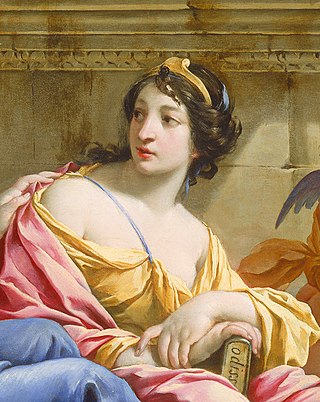Related Research Articles

A nymph is a minor female nature deity in ancient Greek folklore. Distinct from other Greek goddesses, nymphs are generally regarded as personifications of nature; they are typically tied to a specific place, landform, or tree, and are usually depicted as maidens. Because of their association with springs, they were often seen as having healing properties; other divine powers of the nymphs included divination and shapeshifting. Nymphs, like other goddesses, were immortal except for the Hamadryads, whose lives were bound to a specific tree.

In Greek mythology, Proteus is an early prophetic sea god or god of rivers and oceanic bodies of water, one of several deities whom Homer calls the "Old Man of the Sea". Some who ascribe a specific domain to Proteus call him the god of "elusive sea change", which suggests the changeable nature of the sea or the liquid quality of water. He can foretell the future, but, in a mytheme familiar to several cultures, will change his shape to avoid doing so; he answers only to those who are capable of capturing him. From this feature of Proteus comes the adjective protean, meaning "versatile", "mutable", or "capable of assuming many forms". "Protean" has positive connotations of flexibility, versatility and adaptability.

In ancient Greek religion and mythology, Achelous was the god associated with the Achelous River, the largest river in Greece. According to Hesiod, he was the son of the Titans Oceanus and Tethys. He was also said to be the father of the Sirens, several nymphs, and other offspring.

Alpheus or Alpheios, was in Greek mythology a river and river god.

In Greek mythology, Phoroneus was a culture-hero of the Argolid, fire-bringer, law giver, and primordial king of Argos.

In ancient Greek religion and Greek mythology, Minthe is an Underworld Naiad nymph associated with the river Cocytus. She was beloved by Hades, the King of the Underworld, and became his mistress. But she was transformed into a mint plant by either his wife Persephone or her mother Demeter. The plant was also called by some as hedyosmos, which means "sweet-smelling".

Philoctetes, or Philocthetes, according to Greek mythology, was the son of Poeas, king of Meliboea in Thessaly, and Demonassa or Methone. He was a Greek hero, famed as an archer, and a participant in the Trojan War.

In Greek mythology, the naiads, sometimes also hydriads, are a type of female spirit, or nymph, presiding over fountains, wells, springs, streams, brooks and other bodies of fresh water.
In Greek mythology, the Pegaeae were a type of naiad that lived in springs. They were often considered great aunts of the river gods (Potamoi), thus establishing a mythological relationship between a river itself and its springs.
In Greek mythology, the Telchines were the original inhabitants of the island of Rhodes and were known in Crete and Cyprus.

In Roman mythology, Evander was a culture hero from Arcadia, Greece, who was said to have brought the pantheon, laws, and alphabet of Greece to ancient Italy, where he founded the city of Pallantium on the future site of Palatine Hill, Rome, sixty years before the Trojan War. He instituted the festival of the Lupercalia. Evander was deified after his death and an altar was constructed to him on the Aventine Hill.
In Greek mythology, Larissa or Larisa was the name of two different figures that appears in various accounts:

In Greek mythology, Calliope is the Muse who presides over eloquence and epic poetry; so called from the ecstatic harmony of her voice. Hesiod and Ovid called her the "Chief of all Muses".

Arcadia is a region in the central Peloponnese. It takes its name from the mythological character Arcas, and in Greek mythology it was the home of the gods Hermes and Pan. In European Renaissance arts, Arcadia was celebrated as an unspoiled, harmonious wilderness; as such, it was referenced in popular culture.
In Greek mythology, Cychreus was a king of Salamis Island. He was the son of the god Poseidon and the nymph Salamis, daughter of potamoi Asopus and Metope. Salamis was kidnapped by a god and taken to Salamis Island, which was named after her.
In Greek mythology, the name Thronia or Thronie (Θρωνίη) may refer to:
The Anigrides were in Greek mythology the nymphs—that is, the potamides—of the river Anigrus in Elis. On the coast of Elis, not far from the mouth of the river, there was a grotto sacred to them near modern Samiko, which was visited by persons afflicted with skin diseases. They were supposedly cured here by prayers and sacrifices to the nymphs, and by bathing in the river. The earliest known attestation of the cult of these nymphs was from the poet Moero in the 3rd century BCE.
In Greek mythology, Melia or Melie was the name of several figures. The name Melia comes from μελία, the ancient Greek word for ash-tree. In the plural, the Meliae were a class of nymphs associated with trees, particularly ash-trees. There were several other nymphs named Melia, not necessarily associated with trees, these include:

In Greek mythology, Clymene or Klymene was the name of an Oceanid nymph loved by the sun god Helios and the mother by him of Phaethon and the Heliades. In most versions, Clymene is the one to reveal to Phaethon his divine parentage and encourage him to seek out his father, and even drive his solar chariot.
In Greek mythology, Chalcis or Khalkis was a naiad as one of the daughters of the river-god Asopus and Metope, the river-nymph daughter of the river Ladon. Her name means "a brazen pot" from χαλκόν chalcon "bronze".
References
- Strabo, Geography, translated by Horace Leonard Jones; Cambridge, Massachusetts: Harvard University Press; London: William Heinemann, Ltd. (1924). LacusCurtis, Online version at the Perseus Digital Library, Books 6–14